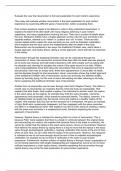Evaluate the view that resurrection is the best explanation for post mortem experience.
This essay will evaluate whether resurrection is the best explanation for post mortem
experience by examining different types of resurrection, before evaluating them.
Post mortem existence needs to be defined in order to fully understand resurrection. It
explains the belief of life after death with many religions believing in post mortem
experience, and many explanations involving the soul. There are a number of beliefs about
the soul. Abrahamic beliefs have a dualist approach as they view the soul and body to be
separate entities, referred to as ‘nefesh’ in Judaism and ‘ruh’ in Islam. There are also
monism beliefs which explain the soul and body as one, such as Aristotle’s materialism
which explains that the soul cannot live independently after the death of the body.
Resurrection can be explained in two ways: the traditional Christian view, which takes a
dualist approach, and replica theory, taking a monist approach, which will both be examined
in this essay.
Resurrection through the traditional Christian view can be understood through the
resurrection of Jesus. His resurrection occurred three days after his death and was physical
as his body was missing, and had bodily interactions with other people such as eating with
his disciples and showing his disciples the marks of the spear wound in his side. William
Lane Craig establishes three facts about the resurrection that prove it happened and that it
was physical: there was an empty tomb, there were appearances of Jesus after his death,
and his disciples thought he had resurrected. Jesus’ resurrection shows the dualist approach
of the traditional Christian view of resurrection as the soul and body are different entities,
shown by the body dying, but the soul of Jesus still existing and later returning to his body,
hence explaining the traditional Christian view of resurrection.
Another form of resurrection can be seen through John Hick’s Replica Theory. This offers a
monist view on resurrection as it explains that the mind and body are inseparable. Hick
explains that after death, God creates a replica of an individual in another world; the replica
is the exact same as the original, for example they hold the same thoughts, memories,
appearances and personality, which preserves personal identity. The replica, however, is in
an idealised state as people may die injured, hence the replica is a healthy replica of the
original. Hick explains that God can do this because he is omnipotent. He gives an example
of John Smith who mysteriously disappears, but then reappears with the same memories
and DNA in a metaphysical world. Hick explains how this is God’s doing of creating a replica
with the same soul and body in a metaphysical world, therefore explaining the monist
approach of resurrection.
However, Replica theory is criticised for claiming that it is a form of resurrection. This is
because Peter Vardy explains that there is a break in continuity between the original dying
and resurrecting as a replica. He explains that because there is this break in continuity, we
cannot be certain that the replica is the exact same person, hence not resurrected. However,
Hick defends his replica theory by saying there is a way to know that the replica is the exact
same through eschatological verification, meaning verification that comes at the end of time:
when we face God, we can verify that the replica is the exact same. However, this response
is criticised as we do not know enough about the end of time to establish eschatological
verification, for example we do not know if verification is the same in post mortem
experience. Furthermore, another criticism of replica theory is through Vardy’s explanation of
us not having experience with people disappearing and reappearing, hence we do not have
sufficient experience to claim replica theory, therefore explaining that resurrection through
replica theory may not be the best explanation for post-mortem experience.




